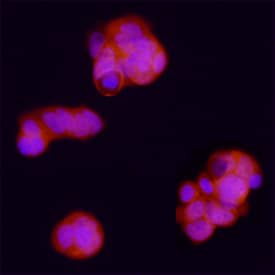Human Bora Antibody
R&D Systems, part of Bio-Techne | Catalog # AF6856

Key Product Details
Species Reactivity
Applications
Label
Antibody Source
Product Specifications
Immunogen
Gly2-Ala180
Accession # Q6PGQ7
Specificity
Clonality
Host
Isotype
Scientific Data Images for Human Bora Antibody
Bora in MCF‑7 Human Cell Line.
Bora was detected in immersion fixed MCF-7 human breast cancer cell line using Goat Anti-Human Bora Antigen Affinity-purified Polyclonal Antibody (Catalog # AF6856) at 15 µg/mL for 3 hours at room temperature. Cells were stained using the NorthernLights™ 557-conjugated Anti-Goat IgG Secondary Antibody (red; Catalog # NL001) and counterstained with DAPI (blue). Specific staining was localized to cytoplasm. View our protocol for Fluorescent ICC Staining of Cells on Coverslips.Applications for Human Bora Antibody
Immunocytochemistry
Sample: Immersion fixed MCF-7 human breast cancer cell line
Formulation, Preparation, and Storage
Purification
Reconstitution
Formulation
Shipping
Stability & Storage
- 12 months from date of receipt, -20 to -70 °C as supplied.
- 1 month, 2 to 8 °C under sterile conditions after reconstitution.
- 6 months, -20 to -70 °C under sterile conditions after reconstitution.
Background: Bora
Bora (Aurora borealis; also C13orf34) is a 61 kDa member of the Bora family of proteins. It is ubiquitously expressed, and plays a key role in cell cycle progression. Plk1 (polo-like kinase-1) is a phosphorylase that is important to the cell during the G2/M transition and mitosis. Its activity is initially regulated by Aurora-A, which phosphorylates and activates Plk1 on Thr210. Bora, Aurora-A and Plk1 all appear to form a complex during G2. Bora predisposes Plk1 to the actions of Aurora-A. Once activated by Aurora-A, Plk1 drives the mitotic mechanism, which includes a third-party phosphorylation of Bora. This initiates Bora dissociation from Aurora-A with subsequent ubiquitination and degradation. Human Bora is 559 amino acids (aa) in length. It contains a Ser-rich region (aa 188-278) and at least eight utilized Ser phosphorylation sites. Phosphorylation may increase the SDS-PAGE MW of Bora to 75-85 kDa. There is one potential alternative start site that lies 60 aa upstream of the standard start site, and a second splice variant the shows a 17 aa substitution for aa 1-87. Over aa 2-180, human Bora shares 84% aa identity with mouse Bora.
Long Name
Alternate Names
Gene Symbol
UniProt
Additional Bora Products
Product Documents for Human Bora Antibody
Product Specific Notices for Human Bora Antibody
For research use only
